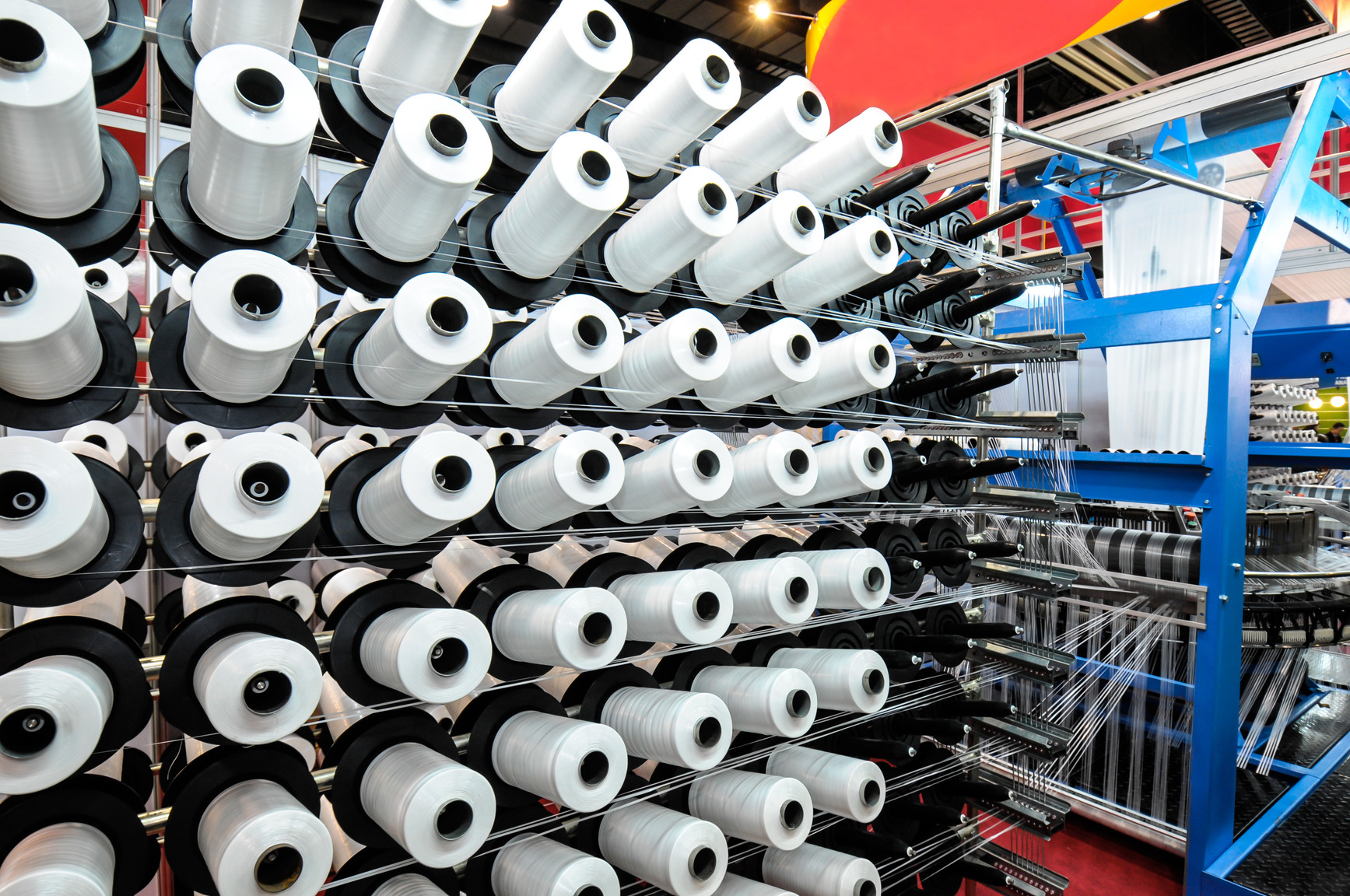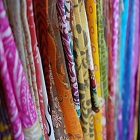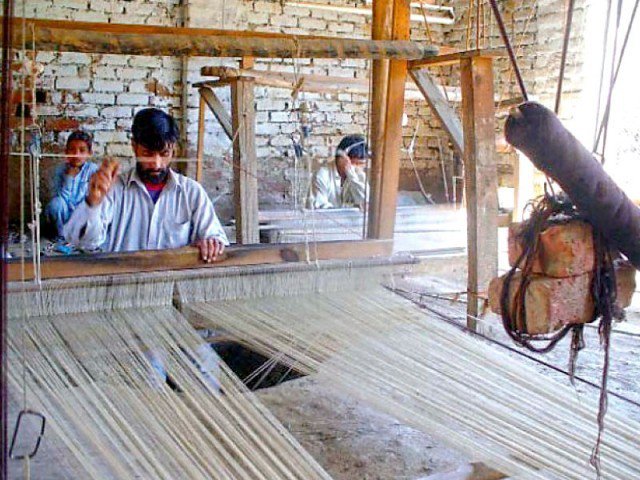FW

Trend reversal with lesser looms
Demand for textiles is rising globally, creating opportunities for Pakistan’s textile Pakistans weaving sector 2exports. The weaving sector is one of the most important sub-sectors, which further comprises of two kinds of set-ups: the organised and the unorganised. However, Pakistan’s textile industry’s growth shows a reverse trend, especially in the weaving capacity of the mill sector. Installed capacity of looms shrunk from 26,000 in 1978-79 to only 8,000 in 2013-14.
The ‘Power Loom’ sector, in the unorganised sector, has around 300,000 looms and major clusters are in Faisalabad, Gujranwala, Gujarat, Multan, Karachi, Kasur and Jhang. Faisalabad though is the biggest cluster with a substantial number of units that have 50 to 100 looms in a single premise as one unit. The organised sector shifted to cotton spinning, instead of making efforts to develop and modernise the weaving sector. Without modernisation of non-mill weaving, it is not possible to diversify the garments/made-ups sector.
To upgrade product quality, reduce production costs, strengthen competitiveness and stabilize operations, it is necessary to install modern looms. The spinning sector comprises 521 textile units (50 composite units and 471 spinning units) with a capacity of around 11.9 million spindles and 214,000 rotors, as per Textile Commissioner Organisation stats.
Cloth production on the rise
The country’s total production of cloth (mill and non-mill sector) rose from 8,524 billion sq. meters in 2005-06 to 11,850 billion sq. meters in 2013-14. More than 90 per cent of the total fabric production comprises of non-mill loom sector. Therefore, this sector’s weaving capacity continues to enjoy a predominant position. High growth in fabric production is due to the setting up of shuttle-less machines. In Pakistan, shuttle-less weaving is supposedly the largest consumer of cotton yarn, while the non-mill weaving sector contributes to the exports by producing low quality sheeting fabrics. Production of cotton fabrics mill-sector increased from 915 million sq. meters in 2005-06 to 1,036 million sq. meters in 2013-14, thus showing an average increase of 2 per cent per year.
Global demand for clothing and textiles is around $18 trillion worth which would most likely rise by 6.5 per cent per year. Pakistan’s share of world yarn trade is about 30 per cent and cotton fabric is about 8 per cent, making it a major cotton textile products supplier to the global market. Export of cotton fabrics rose from 1.79 billion sq. meters worth $1.80 billion in 2009-10 to 2.35 billion sq. meters worth $2.77 billion in 2013-14. An average increase of 13 per cent per annum in terms of value.

The report of the Working Group constituted by the Planning indian textile export 3Commission on India’s exports during 12th Five Year Plan, envisages exports of textiles and clothing at $64.41 billion by the end of March 2017, which given the current situation and numbers looks unachievable. Considerable decline in textile exports
Exports of fibres decreased over 36 per cent up to February last fiscal, while some other textile items witnessed just a 0.4 per cent rise, primarily due to a slowdown in the Chinese market, which accounts for over 70 per cent of India’s cotton and 40 per cent of yarn supplies. Consequently, exports of raw cotton, including waste, dropped almost 47 per cent during the April-February period from a year before.
Experts believe that with demand from China remaining dull and the government withdrawing some export incentives to the sector, shipment target for the current fiscal would be hard to achieve, especially in view of stiff competition from countries like Vietnam, Bangladesh and Pakistan. Neighbouring countries like Vietnam are showing a positive rise in exports. In 2000, Vietnam had a share of only 0.1 per cent in the US imports, which increased to 8 per cent in 2013, making it the second largest supplier country in the US market after China, according to US Department of Commerce.
Similarly, Bangladesh increased its trade share from 4 per cent in 2000 to 11 per cent in 2013 to EU, making it the third largest supplier country in EU-28 market after China and Turkey. Slowdown in the emerging markets like China, Turkey, Brazil, and Russia and developed countries like the member states of the European Union, Canada and Japan are further impacting export growth of India. Industry unsure of achieving growth target
Though a slowdown in China, political unrest in Bangladesh and labour and other issues in Vietnam gave an opportunity to Indian textile exporters, the segment managed to expand its performance rate by just 8.2 per cent over the last three years. While the average annual growth rate of Chinese textile and clothing exports slowed to 6.1 percent since 2012 from as high as 20.1 per cent in 2011, India’s average expansion rate is just 8.2 percent against 15.8 per cent growth rate reported by Vietnam since 2012. Even Bangladesh, despite all the challenges it has been facing, has managed a growth rate of 7.8 per cent.
Experts blame lack of incentives, excessive emphasis on cotton fibre and handlooms by the government, flip-flop in raw material policy, faulty duty structure in the man-made fibre segment where imports of certain raw materials like PTA are taxed higher than those of finished products and inflexible labour laws as hurdles to the growth of the textile and apparel sector. The withdrawal of certain export incentives in the recently-announced foreign trade policy 2015-20 will further make a negative impact.
India’s overall textile and garment exports grew just 5 percent in the last fiscal. While the Textile Ministry has sought a quick resolution of the India-EU free trade agreement, the ministry has also asked for the continuation of the interest subvention scheme, which was withdrawn from late 2014. Currently domestic textile exporters are given a 2 percent export incentive for outbound shipments only to the US, the EU, Canada and Japan but the industry wants incentives to capture markets in countries such as Bangladesh, Vietnam and Cambodia.
On the positive side, the Dun & Bradstreet Report says, manufacturing infrastructure in the textilesector will benefit from the government’s ‘Make in India’ campaign and domestic demand will improve in the coming quarters as economic growth sentiment improves. Increasing labour cost in China will impact cost competitiveness of Chinese textile mills in export markets, creating an opportunity for Indian mills. Exports to Latin American and Asian countries will increase, offsetting slowdown in the European Union region.
texmin.nic.in
Woven garment exports from Bangladesh raced ahead of knitwear in the fiscal year 2014-15. Export of woven garment fetched $13.06 billion in FY 2014-15, up 5 per cent as compared to the previous fiscal year, according to the Export Promotion Bureau (EPB).
During the period, knit earnings stood at $12.42 billion, marking a 3.13 per cent growth. Knitwear had become the top export earning product since the fiscal year 2008. But woven exports started turning positive since the fiscal year 2011-12 with earnings of $9.60 billion while knit earned $9.48 billion. The export growth of knit product, however, was 0.05 per cent in the fiscal year 2011-12. Since then, woven products have emerged strong sustaining their top position.
Industry experts say, the rise in woven garment exports is being led by revised rules of origin by the European Union since January 2011. Under the revised EU rules of origin, clothing exporters can enjoy duty-free access to the European Union even if they source fabrics from other countries.
www.epb.gov.bd
Textech Bangladesh will be held from September 2 to 5, 2015. This is an expo on textile and apparel technology, machinery and allied services. The fair takes place every year in Bangladesh and is a high quality business platform for the textile sector. On a large exhibition area, professional exhibitors present new materials, processing techniques, and sewing machines, knitting machines and much more.
The main focus is to expose the readymade garment industry to latest developments and global trends, so that they can compete and survive in the market. Trade exhibitors come from all over the world and take the opportunity to find new business partners and enter new markets.
This event showcases products from the textile, fabric and yarn industry. Among the exhibits are machinery for winding, texturing, twisting, bonding and finishing of nonwovens and felting, knitting and hosiery machinery, textile printing machinery, dyeing machinery, braiding and embroidery machinery, processing machinery, handling, storing and packing equipment and equipment for recycling.
Major investments in the textile and garment sectors are happening in Bangladesh. Asia accounts for more than 70 per cent of the global production of textiles with South Asian countries emerging as textile powerhouses.
cems-textech.com/
A textile and garment exhibition was held in Cambodia from August 21 to 24. The event exhibited a wide range of products and services. Among them were: advanced sewing machines, automatic embroidering tools, an automatic sock maker, cutting and laying machines, weaving machinery and accessories. It was a platform for participants to build new contacts and networks.
One manufacturer exhibited a sewing machine that is able to create thinner, less visible seams than other sewing machine models. The event is expected to bring more investors to Cambodia by connecting industrial companies and clients and so speeding up Cambodia’s industrialisation. Some companies came to the convention not to showcase technology but to make deals with local producers to deliver highly skilled pieces like embroidery. Convention goers paid greater attention to linking up with Thai producers.
Cambodian manufacturers prefer highly skilled embroidery work to be done in Thailand since Cambodian employees lack the skills to do it themselves. Low salaries in the garment sector in Cambodia are creating a disincentive for local workers to improve their skills.
A major obstacle to selling machines in Cambodia is the country’s lack of skilled technicians. This makes it tough for clients to maintain the purchased equipment.
Germany's popular fabric fair ‘Munich Fabric Start’ will take place from September 1 to 3, 2015. The show kicks off the Autumn/Winter 2016-’17 season. Nearly 1,000 suppliers from 36 countries will present around 1,600 collections featuring the latest fabric innovations. The fashion and clothing industry is offered lots of variety at the start of the season reflecting the entire range of textiles.
Some 20,000 trade visitors from around the world are expected, including buyers and designers from renowned international brands. Numerous first-time registrations are being recorded from brands in Italy, Spain, Great Britain, Scandinavia, Canada, Argentina, Mexico alongside East European countries. A total 150 producers from the Far East will showcase their innovations. This will include suppliers of functional and high performance fabrics, denim and jacquards, prints and embroidery as well as innovative weaves and knits.
The newly opened Atrium 2 will feature a line-up of suppliers from Taiwan representing the latest technology, fashion and function. A sourcing platform for sustainable textiles will feature lace, braids and motifs using GOTS-certified cotton. The upcoming season is characterised by blends with a creative fusing of the past and the future. Both traditional and visionary techniques are equally popular. Colorful ’70s retro influences meet profound Gothic looks and progressive and functional technologies meet substantial authenticity.
www.munichfabricstart.com/
Women’s clothing sizes have undergone tremendous changes through the years. What was a size 16 in 1958, is equal to a size 8 today, and a size 8 dress in 1958 does not even have an equivalent today. Official sizing standards once maintained by the National Bureau of Standards (now the National Institute of Standards and Technology) has cited these measurements in women’ s wear.
Today’s women's clothing sizes apparently have their roots in a Depression-era government project to define the Average American Woman by sending a pair of statisticians to survey and measure nearly 15,000 women, as per Julia Felsenthal who detailed over at Slate.
The National Bureau of Standards published ‘Body Measurements for the Sizing of Women's Patterns and Apparel’ in 1958. The purpose was to provide consumers a means to identify their body type and size from the wide range of body types covered, and enable her to be fitted properly by the same size regardless of price, type of apparel, or manufacturer of the garment. This is when the first women’s clothing size charts were included and it provided data points.
In 1970, again the government updated these standards, however, it was obvious that the ‘representative’ women measured for the standard weren't representatives of all. So, by 1983, the government ditched the standard completely and manufacturers had to define sizes as they saw fit.
After a few years, clothing manufacturers realised that they could flatter consumers by revising sizes downward. Also, different manufacturers defined sizes differently. A non-governmental international standards organization, The American Society of Testing and Materials, began trying to restandardise women's sizes in the 1990s. Yet, women find it frustrating to get the right size and navigate through the chaos of arbitrary sizing on their own.
A report by Persistence Market Research (PMR) confirms, brings out some recent trends in pigments and dyes market include shifting of manufacturing facilities from the US and Europe to India, China, and Taiwan, and the rising preferences for eco-friendly products. With its emerging economies and quickly growing manufacturing bases, Asia Pacific accounts for the largest market and is likely to remain the highest growing region in the years to come.
Demand for pigment and dye products such as printing ink is driven by several factors such as technological development and increasing demand for digital inks. It says an increase in end-user preference for environment-friendly products is likely to drive growth of dyes and pigments market in the near future.
A pigment is a chemical material, which alters the colour of reflected or transmitted light due to wavelength-selective absorption. Based on product, the pigments and dyes market is classified into two parts, namely dyes and organic pigments, and inorganic pigments. Based on application, the pigments and dyes market are classified into textiles, leather, paper, paints and coatings, plastics, constructions, paper & specialty, printing inks, and others.
www.persistencemarketresearch.com
The government has not yet accepted farmers’ demand of setting a minimum support price, as new cotton has arrived in the market. This may result in losses to growers for yet another year. Since the beginning of August there have been new stocks in the market and prices are declining compared to last year. Last year, the price of cotton seed (Phutti) was in the range of Rs 2,500 to Rs 2,800 per maund (40 kg), which depended on the quality. This year, the new crop is being sold in a price range of Rs 2,000 to Rs 2,300 per maund. This is at least 20 per cent less than 2014.
A minimum support price of cotton is being demanded by the farming community. This is aimed at saving them from potential losses. However, officials say the Ministry of National Food Security and Research has not taken any decision on the issue. The international market is also slowing down due to unconsumed stocks of previous year, say cotton traders, which is also adversely affecting price new crop.
Farmers are not getting fair return, say cotton growers, and the situation is creating unrest among cotton growers. Also, China, which is the main buyer of Pakistan yarn, is going through an economic meltdown, which is gravely affecting Pakistan. Besides, the spinning industry is facing heavy taxation.
Due to drought, cotton growers and buyers in Tanzania’s lake zone would suffer substantial losses this year. The drought has affected the production of the cast crop greatly. Acute shortage of seed cotton has put almost all cotton ginners’ business in crisis and the hardest hit are cotton buyers who snubbed the contract farming system.
Serapion Rujuguru, Head of Agriculture Department in Bunda District Council feels cotton buyers are jostling for whatever little produce is available. Besides the bad weather, the collapse of contract farming has had a negative impact on cotton production in the district. Farmers say this is the worst year they have seen since they started growing cotton. While they normally harvested 1,270 kg of seed cotton per acre on an average, they managed only 900 kg from three acres this season. Experts blame the problem on collapse of contract farming, saying that though drought took its toll on production, unreliable access to farming inputs had exacerbated the problem.














